
Explore the vast sci-fi universe and immerse yourself in war, politics, and empire management.
| Genre | 4X Grand Strategy |
| Developer | Paradox Development Studio |
| Publisher | Paradox Interactive |
| Platform | PC, Xbox One, PS4 |
| Release Date | May 9, 2016 |
Stellaris is a unique and vast strategy game that can be incredibly addictive and the complexity is where the fun lies the most. Without a doubt, Stellaris is one of the best PC games of all time, but we must say, it is an acquired taste. First off, let’s just say that Stellaris can be a very overwhelming game at first, especially if you didn’t play any “Civilization-type” games before.
It combines everything from politics and trade to Black Holes and extradimensional beings. It truly is a whole package when it comes to a sci-fi game. It’s simply difficult to learn and impossible to master. Furthermore, there is always a new empire build, a new RNG element, and a new scenario.
Stellaris Gameplay Introduction

Credit: Paradox Interactive
In order to get a feel of the vast content of this game, you have to play it a few times, it isn’t your typical RTS experience. The game starts in the year 2200 and progresses into 2500. You can befriend, be at war, trade, make vassals, and make federations with almost anybody and everybody. Depending on the size of the map, the number of AIs, and how much you pause during the game, it can take a lot to finish just one scenario. In the early game, you expand your empire, see who are your neighbors (maybe a peaceful Pacific Fish Empire, or an AI Exterminator), and explore the galaxy.
Mid-game is typically where wars, economy, and politics are at play the most. The end-game is usually dominated by the “Endgame Crisis” mechanic. We don’t want to spoil it too much, because the exploration is where the game shines the most. Multiplayer can be fun, but we are not the biggest fan of it. The nature of Stellaris gameplay is exploration, role play, strategy, and learning. Overall, multiplayer dumbs it down to optimal build and just playing to win, which kind of defeats the main purpose of the game.
Customization
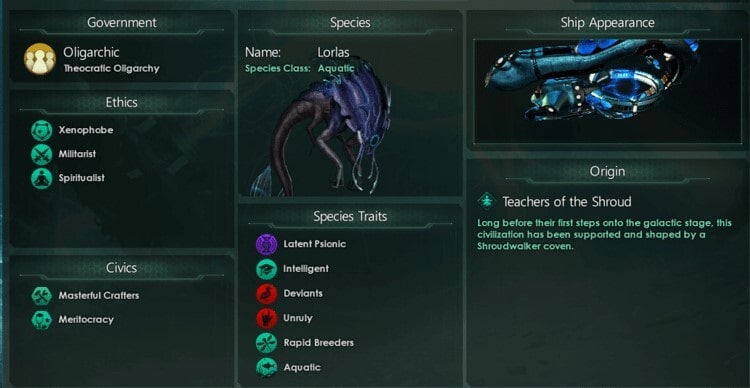
Screenshot: Stellaris
We all know a lot of games where there is a “role play” element added to it, but in reality, it’s just names and labels that don’t mean anything. Stellaris really has a genuine Empire customization experience. For example, in the picture above, we play as a fish empire Lorlas. We are intelligent species (which gives us a boost in science) and have the Xenophobe ethic, which means we will be hostile towards our neighbors. Furthermore, Latent Psionic means that they will have awakenings, and a ruler can become The Chosen One and become Immortal.
This all goes to show how just one trait can influence the game a lot. It’s a true role play as each thing you set, in the beginning, will follow you throughout the game. If you set to be an AI Exterminator, you then can’t talk to anyone except other AIs and everyone hates you. Your main goal is to exterminate everyone by any means. When you play the game from this perspective, it feels like a vastly different experience than playing as, for example, a Pacifist Reptilian Republic.
There are a lot of things to comprehend when building your empire:
- Ascensions
- Origins
- Traits
- Civics
- Traditions
There are a lot of combinations and experimenting is where the fun is. We just want you to get a sense of how things work and to encourage you to explore further, cause exploration is one of the most exciting parts of this game.
Basic Stellaris Gameplay Mechanics
Politics
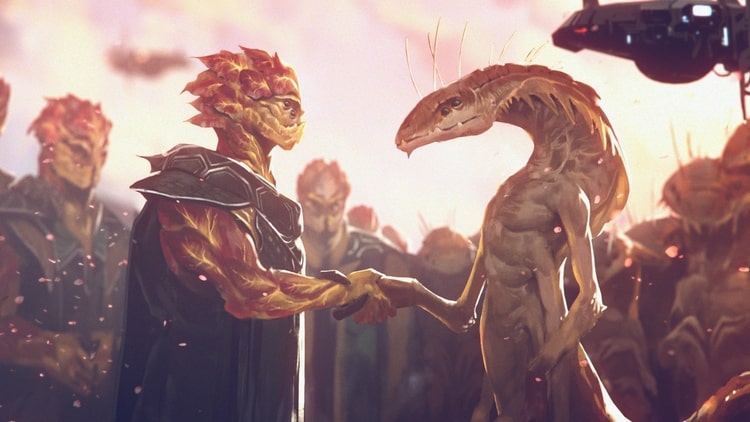
Credit: Paradox Interactive
When we talk about politics in this game, we have a lot on our table. In each game, you learn something new in regard to politics, even with over 100 hours of playtime. To be a bit more concise, we have systems like federations, treaties, secret pacts, the vassal system, espionage, trade markets, slave markets, and so on. If you decide to be an AI Exterminator, you have no politics but to exterminate. On the other hand, you can be a xenophile and a pacifist and try to be in good relationships with everybody. For instance, there is an option to make pacts and attack together.
Furthermore, you can even share fleets in a federation. Each of these paths gives you bonuses and different options in the game. It’s not like if you don’t wage war all the time you can’t do anything. There are many things to do to get ahead. This just goes to show how many fronts you can make an effort on and reap the benefits. Politics in Stellaris is one of the best this genre has to offer.
War
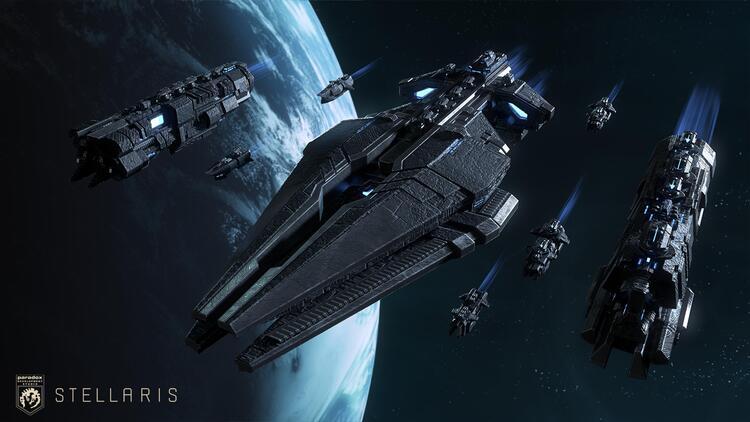
Credit: Paradox Interactive
War is a big part of Stellari’s experience, it’s almost unavoidable, and each empire wages war differently. It uses some cool concepts like designing your ships and countering enemies with the correct ship pattern. Some reasons for war can only be defensive, and some wars are just straight-up extermination reasons. Furthermore, there are a ton of ways how you want to deal with your enemy (purge or enslave people). It generally comes down to what type of civilization are you.
Maybe you want slaves for your mines, or you want equality and liberty for the conquered people, it’s all up to you and your roleplay style. Do note, even though there are all kinds of playstyles, even as a pacifist, you will have to fight someone like an AI Exterminator or an Awakened Empire that wants to conquer the whole galaxy.
Midgame/Lategame Crisis
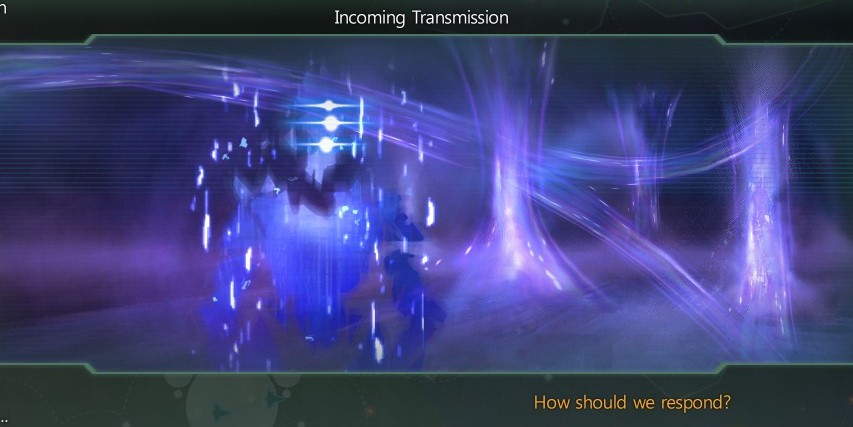
Screenshot: Stellaris
Events are something that makes each new game quite unique. In one game you may have an asteroid heading toward your planet, in another, you may have a physical anomaly event that you have to explore. The one event that is inevitable is the Endgame Crisis. This is the most important event in the game.
Basically, one of three threats will come to the galaxy and you will need to find a way to defeat it. This is usually the best time to gather your forces and stop waging wars with other civilizations since this crisis is a threat to the whole universe. As we mentioned earlier, we don’t want to spoil anything for you so you can have the best experience.
Mods
The steam workshop does wonders for this game. We usually don’t recommend installing mods since it can mess with the basic Stellaris gameplay mechanics. However, there are some excellent UI mods and stuff that just doesn’t interfere with the base game. Basically more options, more fun. We recommend the UI Overhaul Dynamic and the Tiny Outliner v2 mod. These two mods will massively improve your interface and make everything more compact.

Regular Updates Keep The Game Alive
Another big plus to this game is that it’s still being updated. We are not talking about the DLCs, but rather just updates that change and improve the base game mechanics. We may not like the old-school business model of stacking DLCs, but the developers have more resources and update the game because of it. For a game that is mainly played single-player, to have regular updates 6 years later is very refreshing and welcoming.
The DLC issue
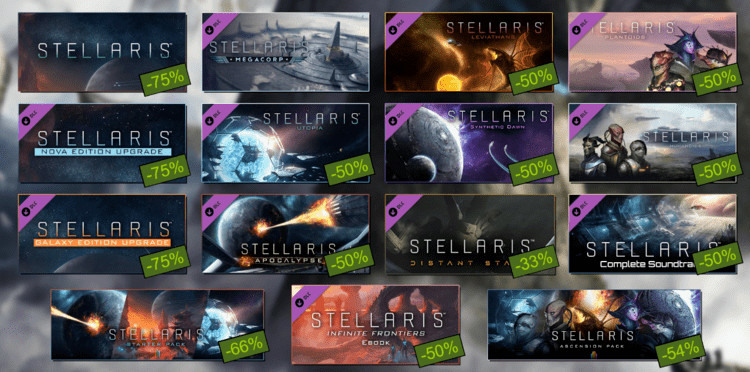
Credit: Steam Store
One big problem is the price. As we already mentioned above, this game does have a “DLC problem”. The main game can be found if you catch a Steam discount or on G2A for a few bucks, but there are a lot of DLCs and they all add to the experience. We recommend getting the base game and some of the best Stellaris DLCs: Utopia, Federations, Megacorp, Distant Stars, and Leviathans. Honestly, the base game without these DLCs is kind of barebones and not a full experience. The more DLCs you buy, the richer the experience and content of the scenario.
You can start off with a few DLCs and then build up over time. Consequently, we kind of understand the price because the game has a colossal amount of content in it and is constantly improved and updated. We created a Stellaris DLC tier list to determine what to buy first. Regardless, the DLCs build up on each other, so the more the merrier!
Last thoughts on the Stellaris gameplay experience
All in all, we find Stellaris a sci-fi dream and a must-have experience for any strategy fan. The game has its flaws, but they are overcome with good mechanics and a lot of systems and content that make the game very deep and fun. We would urge you to try it if you like strategy games in general. Maybe it will take a day or a week to get into the whole Stellaris gameplay, but it’s worth it.
